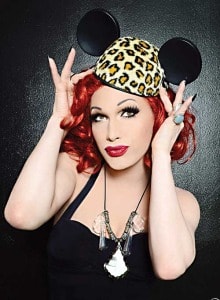
When Jinkx Monsoon (the drag persona of Seattle-based theatre actor Jerick Hoffer) won the fifth season of “RuPaul’s Drag Race,” it propelled her performing career to the next level. The Vaudevillians, a comic cabaret show she developed with her musical partner, Major Scales (a.k.a. Richard Andriessen), ran for four months at New York City’s Laurie Beechman Theatre, hit Provincetown, Mass., in the summer, and will run Oct. 3–Nov. 2 at Seattle Repertory Theatre.
ROB WEINERT-KENDT: Jinkx is playing another character, Kitty Witless, in The Vaudevillians. How is Kitty different from Jinkx, if at all?
JINKX MONSOON: Both me and my music partner have stage personas; Jinkx and Major are the base we start at. If Jinkx is kind of a drunken, narcoleptic, zany chanteuse, Kitty’s a more extreme version of that. First we get into drag, then we get into these other characters.
How did you start doing drag?
I started at 15. I did plays in high school, but I wanted to perform in much more than just two plays each year. I started doing drag as an outlet for my excess creativity.
In theatre, do you play male or female roles?
I’ve been both male and female—in Shakespeare, in Brecht, in musicals. I played a nine-year-old boy in a show based on a children’s book. I’ve played Velma von Tussle in Hairspray, Angel in Rent, Hedwig, and Moritz in Spring Awakening. I play either child-aged boys or middle-aged women.
The Vaudevillians started very small in Seattle, and now it’s at the Rep, the biggest theatre in town.
It’s surreal for us! We first did the show there at the Balagan, this little basement theatre; tickets were just $7. If some night we didn’t have enough customers, I’d go out on the street and bark at passersby. It actually prepared us for Provincetown, because barking for your show is a big part of P-Town.
Then we did it at a restaurant in Seattle called the Rosebud, and it was free. It started out very small, and some nights people were more afflicted by our show than really came to see it. But it kept growing, and started to have a cult following. It was partly the gay scene in Seattle coming to see Jinkx Monsoon’s show, partly theatregoers who had seen our work elsewhere, and partly the burlesque community. Then I had to leave for “Drag Race,” and it was on pause for about a year while I toured America and Europe.
You did the show for about four months in New York. It was “Drag Race” that made that happen, right?
For the first month and a half, it was the “Drag Race” audience that came—they would catcall the stage very much as if they were at a drag show. Then, after the New York Times review, the audience sort of changed, and their behavior was much more like a traditional theatre audience.
Did you miss the catcalls, or do you prefer a quieter audience?
If an audience can be raucous when it’s time to be raucous, then completely shut up for the rest of it, I’m happy. We have our tricks to get them to settle down if they’re interrupting. If someone steps on my punchline once, I’ll let it go, but if they do it again I’ll say, “That’s funny, honey, but if you step on one more punchline, I’m coming for blood.” I’m not afraid to lay into an audience member who’s disrupting the show. Kitty Witless is kind of a crass, ballsy character, though in her mind all she’s doing is trying to uphold the sanctity of live theatre.
On “Drag Race,” though you won the season, you caught flak for being too character-y, not put together enough.
That had a lot to do with my aesthetic. When you do a drag character in Seattle, it’s perfectly all right to take that character to an ugly level. Some of the most successful performers in Seattle play around with our ideas of beauty; they take on a grotesque aesthetic. Dina Martina is more like a shock or a dirtbag drag queen; she makes no attempt to look good. Or Waxie Moon, he’s one of the top boylesque performers in Seattle, and he’s a tall, gawky bald man with a handlebar moustache and a woman’s cocktail dress. I always wanted to look more like a real woman than a drag queen—and like a crazy woman, like the kind you see on the bus, where they’ve got too much makeup and they’re dressed up to go to a party, but it’s noon. They’re completely put together, but one of the wires got pulled out.
On “Drag Race,” all the judges were always saying, “We love your character, but there’s no reason you have to be ugly and crazy; she could be pretty and crazy.” Since then, I’ve kind of embraced the more glamourous aesthetic, a more elevated and much more polished package. It’s Jinkx 2.0. And that makes it all the more delightful to play a crazy lady, to come out all put together and then let it unravel. It’s more fun than to just start out crazy.
Do you have any dream roles?
My top dream role is to play Mrs. Lovett in Sweeney Todd. I feel I could play her just earnest and honest enough. I played Jack in Into the Woods, I’d love to revisit that role. Oh, and Elder Cunningham in The Book of Mormon.

